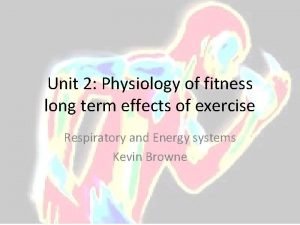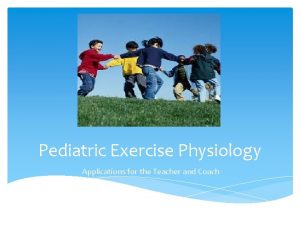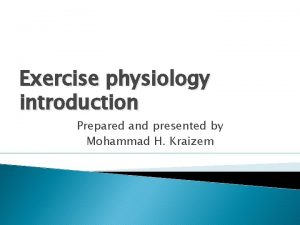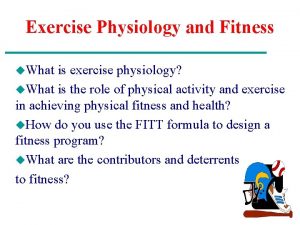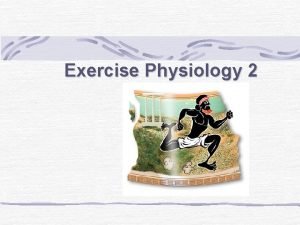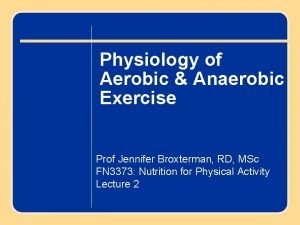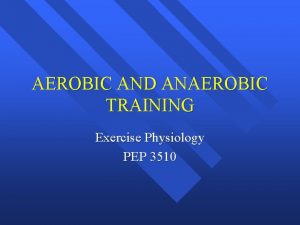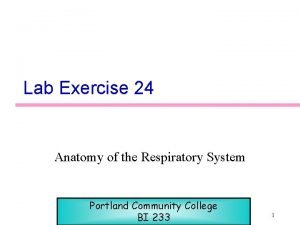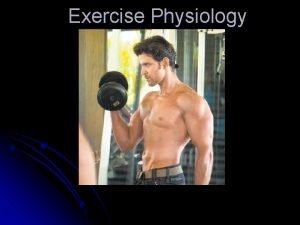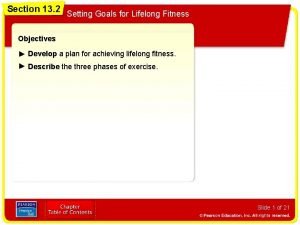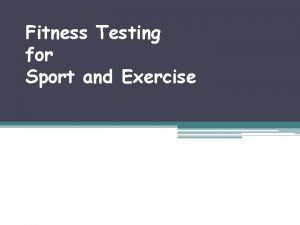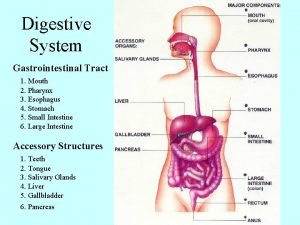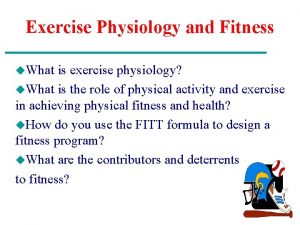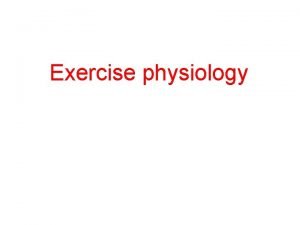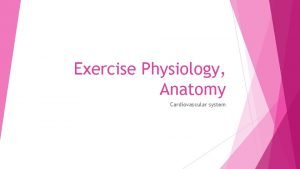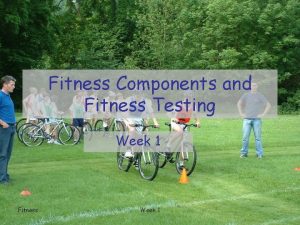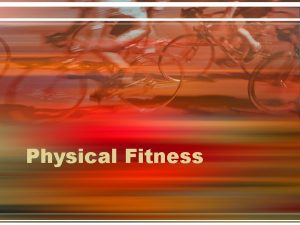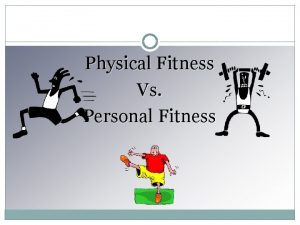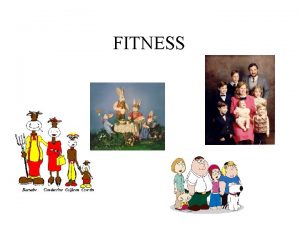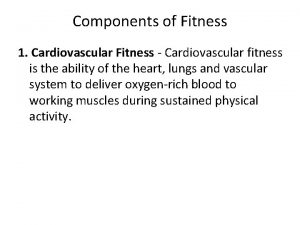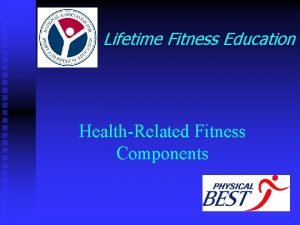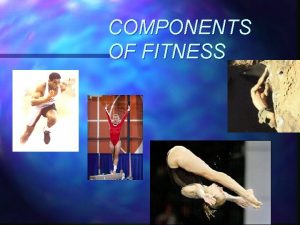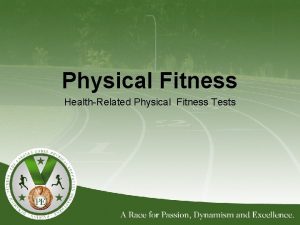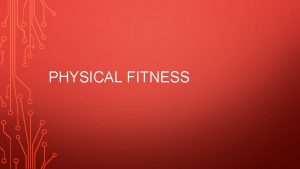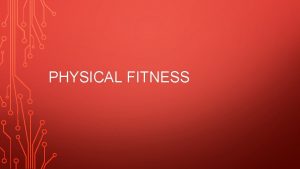Exercise Physiology and Fitness Exercise Physiology and Fitness



































- Slides: 35

Exercise Physiology and Fitness

Exercise Physiology and Fitness u. What is exercise physiology? u. What is the role of physical activity and exercise in achieving physical fitness and health? u. How do you use the FITT formula to design a fitness program? u. What are the contributors and deterrents to fitness?

Exercise Physiology u The study of the effects of exercise on the body. u Body’s responses and adaptations to exercises ä System to subcellular level ä Acute (short term) to chronic (long term) adaptations u Population served ä Elite performer ä People of all ages and abilities

Physical Fitness u Ability of the body’s systems to function efficiently and effectively. u One is “physically fit” if they have the ability to: ä “carry out daily tasks with vigor and alertness, without undue fatigue, and with ample energy to enjoy leisure-time pursuits and to meet unforeseen emergencies. ”

Physical Fitness u Health fitness ä Body composition ä Cardiorespiratory endurance ä Flexibility ä Muscular endurance ä Muscular strength u Performance or skillrelated fitness ä Agility ä Balance ä Coordination ä Power ä Reaction Time ä Speed

Physical Activity, Physical Fitness, and Health u Hypokinetic diseases ä Diseases caused by insufficient physical activity, often in conjunction with inappropriate dietary practices. u Dose-response debate ä What kind of activity? ä How much time spent in activity? ä At what intensity should it be performed? ä How often in order to see benefits?

Physical Activity and Health u 1996: : ä “Individuals who engage in moderate intensity exercise for at least 30 minutes for most, or preferably all, days of the week, can improve their health and decrease their risk for disease. ” u Additional health benefits can be derived from increasing the time and/or intensity of physical activity. u It’s never too late to be active!

Health Benefits u Enhanced cardiovascular function u Reduction of many cardiovascular disease risk factors u Increase ability to perform tasks of daily living u Reduced risk of muscle and joint injury u Improved work performance u Improved physical appearance, self-image, and sound mental health

Health Benefits u Reduction of susceptibility to depression and anxiety u Management of stress u Enhancement of self-concept and esteem u Socialization through participation in physical activities u Improved overall general motor performance u Energy u Resistance to fatigue u Mitigate the debilitating effects of old-age or retain a more desirable level of health for a longer period of time

Energy Production for Physical Activity u Use of ATP as energy to perform muscular activity. Two ways to produce ATP: u Anaerobic system ä Without oxygen ä High energy expenditure, short time (6 -60 seconds) u Aerobic system ä With oxygen ä Lower rate of energy expenditure, longer period of time (more than 3 minutes)

Principles of Athletic Training u The effectiveness of athletic training depends on how well the athlete follows certain basic principles. Based on extensive research in the physiological and behavioral sciences, the eight fundamental rules listed below apply to all sports, according to Dr. John Kernan, collegiate coach and athletic researcher. They apply equally well to preparation for intense competition and for achievement of long-term fitness goals.

The Principle of Individuality Individual differences impact a person's response to an exercise program. Some of these are age, gender, genetic makeup, size and shape, athletic history and chronic conditions or injuries. For example, women may need more recovery time than men, and older athletes may require more time than younger ones. In practical terms, this means that there is no "one size fits all" exercise program. Athletic activity should be tailored for the athlete's physical capabilities and athletic goals.

The Principle of Progressive Overload Increased workload results in improved fitness, strength and endurance. To increase strength (including cardiovascular strength), muscles must be stressed by working against a greater than normal load. To increase endurance, muscles must be worked for longer periods or at higher intensity than they are used to. These training loads should be gradually increased to assure proper training effect and to prevent injury.

The Principle of Adaptation The body adapts to increased physical demands. This results in enhanced athletic performance and more efficient use of energy. However, performance is likely to plateau if a particular workout is followed routinely. Variations in intensity, duration and type of exercise should be introduced to provide new physical challenges, prevent staleness and increase the training load.

The Principle of Specificity To increase performance in a particular exercise or sport, the athlete should practice that sport. For example, swimmers should swim and runners should run. To prepare for competition, training should include objectives, method and content similar to what the athlete will face, according to coaching expert Dr. Tudor Bompa. In addition, other activities, such as strength training, may supplement basic workout routines and enhance capability in the target sport.

The Principle of Warm-up and Cool Down Warm-up through low-intensity activity increases blood flow to the working muscles and prepares them for high-intensity tasks. Physiologically, proper warm-up increases body temperature by one to two degrees. Following exercise, cool down helps transfer blood from working muscles back to vital organs. Cool down also is essential for removing metabolic wastes.

The Principle of Rest and Recovery The body regenerates during rest, becoming better and stronger than before. The athlete should maintain proper rest intervals between training activities and get plenty of sleep.

The Principle of Hard-Easy Workouts A "Hard-Easy"system eliminates over-training, prevents mental burnout and results in greater progress over time. One or two hard workouts per week, with the other days devoted to light or moderate training, will result in greater progress than always working at maximum intensity.

The Principle of Reversibility De-training occurs rapidly once a person stops exercising. Therefore, it is important to maintain some level of exercise--even if minimal--if circumstances prevent regular training. For example, when travel or work demands interfere with the normal routine, even one day per week will slow reversibility. Likewise, cross-training in the case of injury helps maintain overall fitness.

The Principle of Supercompensation

Time of recovery for Supercompensation u Speed: 8 -24 hours u Soft aerobic workout: 10 -14 hours u Medium aerobic workout (150 -170 bpm): 24 -36 hours u Muscle strength and anaerobic workout: 48 -72 hours

Planning a Fitness Program u Threshold of training ä Minimal level of exercise needed to achieve desired benefits. u Target zone ä Defines the upper limits of training and the optimal level of exercise. u FITT formula ä Frequency, Intensity, Time, and Type ä Manipulate these factors to produce an individualized exercise program. u Needs and goals of individual ä Program should meet the goals of the individual

FITT formula u Frequency ä Number of sessions each week u Intensity ä Degree of effort put forth by the individual during exercise. u Time ä Duration of activity u Type ä Mode of exercise being performed

Cardiorespiratory Endurance u Body’s ability to deliver oxygen effectively to the working muscles to perform physical activity. u Most important component of health fitness. u Helps prevent hypokinetic disease. u Concerned with the aerobic efficiency of the body.

Cardiorespiratory Endurance u Frequency: u Intensity: u Time: u Type: – – – – 3 to 5 times per week 60% to 90% HRMAX 20 - 30 minutes Aerobic activities Jogging Running Walking Dancing Cross Country Skiing Biking Swimming

Target Zone u HRMAX=220 bpm - age u Target zone = 60% to 90% HRMAX u Lower threshold target HR= HRMAX x 60% u Upper threshold target HR= HRMAX x 90% u Calculations for a 20 -year-old ä HRMAX =220 -20=200 bpm ä Lower threshold = 200 bpm x 60%=120 bpm ä Upper threshold = 200 bpm x 90%=180 bpm

Muscular Strength and Endurance u Muscular strength is the ability of a muscle or a muscle group to exert a single force against a resistance. u Muscular endurance is the ability of a muscle or muscle group to exert force repeatedly or over a period of time. u Maintenance of proper posture; protect joints. u Production of power to enhance performance. u Use it of lose it!

Exercises u Isometric exercises ä Muscle exerts force against an immovable object. ä Static contraction u Isotonic exercises ä Force is generated while the muscle is changing in length. ä Concentric and Eccentric contractions u Isokinetic exercises ä Contractions are performed at a constant velocity. ä Cybex and Orthotron machines

Development of Muscular Strength and Endurance u Principle of Overload is critical. u Repetition is the performance of a movement through the full range of motion. u Set is the number of repetitions of performed without rest. u Strength ä Low number of repetitions with a heavy resistance. u Endurance ä High number of repetitions with a low resistance. u FITT

Flexibility u Maximum range of motion possible at a joint u Joint specific: better range of motion in some joints than in others. u Can prevent muscle injuries; improve low-back pain u Decreased flexibility can be caused by: ä Sedentary lifestyle (lack of use of muscles) ä Age ä High amounts of body fat ä Stress

Flexibility u Improvement of flexibility ä Ballistic stretching » Momentum generated from repeated bouncing to stretch. » Not recommended- may overstretch the muscle. ä Static stretching » Slowly moving into a stretching position and holding for a certain period of time (10 -30 seconds; 5 times). ä Contract-relax technique » Relaxing of the muscle to be stretched by contracting the opposite muscle (hamstrings/quadriceps) u Measurement of flexibility-goniometer

Effects of Training Lower oxygen consumption Lower pulse rate Larger stroke volume Lower rise in blood pressure Slower respiration rate Lower rate of lactic acid formation Faster return to “normal”

Effects of Training Greater cardiorespiratory efficiency. Greater endurance. More “work” can be performed at less cost. Improvement in fitness components. Coordination and timing of movements are better.

Physical Activity & Health u Adults - 30 minutes of physical activity equal to brisk walking on most, preferably all, days of the week. u Activity of greater intensity will yield greater health benefits. u Strength-developing activities at least twice a week.

Deterrents to Fitness u Dietary practices u Tobacco u Excessive alcohol consumption u Use of drugs u Inappropriate stress management approaches
 Exercise physiology for health, fitness, and performance
Exercise physiology for health, fitness, and performance Physiology of sport and exercise 5th edition
Physiology of sport and exercise 5th edition Increased aerobic and anaerobic enzymes
Increased aerobic and anaerobic enzymes Health related skill
Health related skill Pediatric exercise physiology
Pediatric exercise physiology Meaning of exercise physiology
Meaning of exercise physiology What is fitness
What is fitness 2 types of exercise
2 types of exercise Uk myeloma forum
Uk myeloma forum Exercise intro chapter 1
Exercise intro chapter 1 Anaerobic exercise physiology
Anaerobic exercise physiology Exercise physiology quiz
Exercise physiology quiz Bronchi histology
Bronchi histology Mabp = co x tpr
Mabp = co x tpr Chapter 13 exercise and lifelong fitness
Chapter 13 exercise and lifelong fitness Fitness testing for sport and exercise
Fitness testing for sport and exercise Upper respiratory system
Upper respiratory system Tattoo anatomy and physiology
Tattoo anatomy and physiology International anatomy olympiad
International anatomy olympiad Structure anatomy and physiology in agriculture
Structure anatomy and physiology in agriculture Anatomy and physiology bones
Anatomy and physiology bones Triple therapy for peptic ulcer disease
Triple therapy for peptic ulcer disease Microbial physiology lecture notes
Microbial physiology lecture notes Liver hilus
Liver hilus Podbřišek
Podbřišek Difference between anatomy and physiology
Difference between anatomy and physiology Red blood cells anatomy and physiology
Red blood cells anatomy and physiology Chapter 14 anatomy and physiology
Chapter 14 anatomy and physiology 3 layers of muscle
3 layers of muscle Git layers
Git layers Http://anatomy and physiology
Http://anatomy and physiology Chapter 1 introduction to human anatomy and physiology
Chapter 1 introduction to human anatomy and physiology Appendix physiology
Appendix physiology Aohs foundations of anatomy and physiology 1
Aohs foundations of anatomy and physiology 1 Aohs foundations of anatomy and physiology 1
Aohs foundations of anatomy and physiology 1 Anatomy and physiology of swine
Anatomy and physiology of swine


